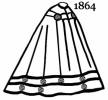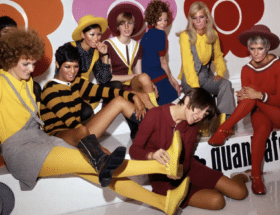By Pauline Weston Thomas for Fashion-Era.com
- From Victorian Romantic Era to Edwardian Cloaks and Capes
- 1890's Cloaks
- The Semi Tailored Cloak
From Victorian Romantic Era to Edwardian Cloaks and Capes
Fashion history shows that women are ever changing their minds about long versus and short and it was the same with cloaks. As well as longer versions, shorter cloaks were in vogue from 1850 and were ideal cover ups for wearing over the wider crinolines styles.
Cloaks were perfect to disguise pregnancy effectively for the Victorian fashion of large families and along with the shawl they were an essential female garment. The mantle cloak in the header up on the right of the page is similar in cut to the line drawing of 1843 directly below.
1843 Mantle Cloak Fur Trim
Mid-Victorian Hip Cloak


The short cloak construction was often merged with the hip length mantelet styles with semi fitted or hanging loose sleeves. You can see in the illustrations below that the cape and the mantelet had a similar silhouette as the 1880s progressed.
1887 Mantelet Front
Mantelet Back


Read more about Mantelets and see a good range of colour fashion plate picture examples in the Mantelet pages. Other jacket styles were also popular and they are illustrated in other coats and jackets.
1890s Cape
In the 1890s tailored masculine inspired coats and suits were thought ideal for the new woman because they were practical and unobtrusive in appearance. But the huge sleeves of finer weight more feminine garments, meant that a top layer in the form of a short cloak often now called a cape was essential to keep the torso warm.
Elderly women opted for the semi-tailored functional look as shown in the first four styles below. Hip length cloaks like these existed alongside the shorter versions shown on the next page.
For those involved in historical costume re-enactment, getting the style correct for the age of the wearer will ensure a more authentic look to a production.
More Elderly Cloak Styles


Formal Cloaks
Feminine styles reigned for formal occasions and high shouldered much shorter waist and above waist length capes big enough to fit over the huge sleeve variations of the 1890s were ideal. In costume history terms this was the era of La Belle Époque and the decorative capes are a good illustration of the embellishment skills executed at the time when everything was made as ornate and beautiful in keeping with the mood of society.
The much more flirtatious, youthful frivolous styles of cloaks and capes, along with typical fabrics of the 1890s, are illustrated on the next page.




